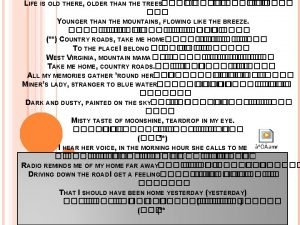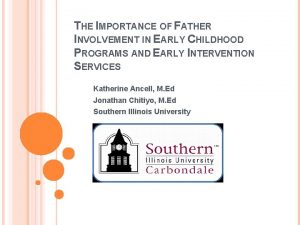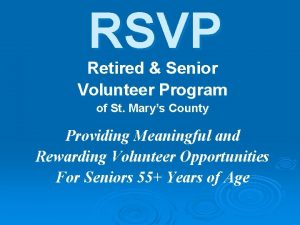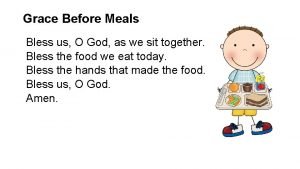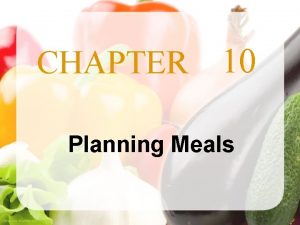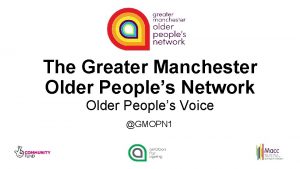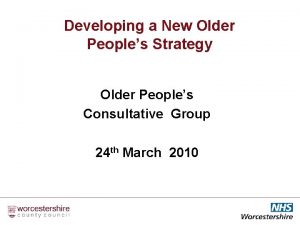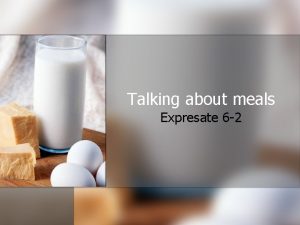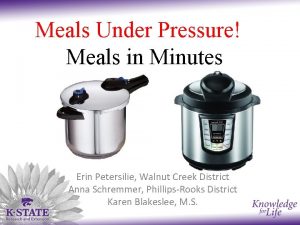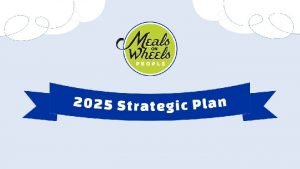Older peoples involvement in activities related to meals













- Slides: 13

Older people’s involvement in activities related to meals in nursing homes Vigdis Abrahamsen Grøndahl, RNT, MSc, Ph. D Heidi Aagaard, RNT, MSc Associate Professors in Nursing Science Faculty of Health and Welfare Østfold University College NORWAY

Statement of the Problem Eating and drinking are fundamental human needs Residents of nursing homes are vulnerable to malnourishment • The reported incidence varies from 10% to 60% Participation of older people in activities related to food and meals can prevent malnourishment Residents appear to have limited opportunities to influence meal situations Page 2

The purpose of the study 1. To explore how residents in nursing homes perceive their participation in activities related to food and meals. 2. To explore possible factors influencing the residents participation. Page 3

Methodology & Theoretical Orientation A cross-sectional survey design A face-to-face interview questionnaire A total of 204 residents (88 percent) in one Norwegian county participated The Norwegian Social Science Data Services approved the study (Ref. number 21083) Descriptive and comparative statistics were used Page 4

Results I Table 1 a. Characteristics of the residents (N=204) Variable Gender Male Female Age ≤ 65 years 66– 75 years 76– 85 years ≥ 86 years Body mass index (BMI) (N=174) 13– 19 20– 21 22– 27 28– 29 30– 39 Length of stay at the nursing home ˃ 4 months 4 – 12 months ˃ 12 months Page 5 N (%) 53 (26. 0) 151 (74. 0) 11 (5. 4) 23 (11. 3) 69 (33. 8) 101 (49. 5) 24 (13. 9) 29 (16. 8) 84 (48. 6) 7 (4. 0) 29 (16. 8) 68 (33. 8) 43 (21. 4) 90 (44. 8)

Results II Table 1 a. Characteristics of the residents (N=204) Variable N (%) Residents' appetite Poor Good Very good Problems with chewing Yes No Problems with swallowing Yes No 29 (14. 4) 122 (60. 4) 51 (25. 2) 33 (16. 5) 167 (81. 9) 24 (12. 1) 175 (85. 8) Page 6

Results III Table 1 b. A description of the nursing homes Page 7 Variable N (%) Number of residents at the nursing home ≤ 30 (small) 31 – 80 (medium) ≥ 81 (large) Dinner from own main kitchen Yes No 13 (6. 5) 127 (63. 5) 60 (30) 73 (36. 5) 127 (63. 5)

Results IV Table 2. The residents' participation in activities related to food and meals (N=204) 1 Never n (%) 2 Now and then n (%) I can have food beyond regular mealtimes (n=119) 28 (23. 5) 11 (9. 2) I take part in planning menus (n=199) I take part in food preparation (n=156) I take part in setting the table (n=145) I take part in clearing up after meals (n=144) 197 (99. 0) 2 (1. 0) 0 0 146 (93. 6) 4 (2. 6) 2 (1. 3) 140 (96. 6) 2 (1. 4) 3 (2. 1) 0 138 (95. 8) 2 (1. 4) 3 (2. 1) 1 (0. 7) Page 8 3 Often 4 Always n (%) 30 (25. 2) 50 (42. 0)

Results V Table 2. The residents' participation in activities related to food and meals (N=204) 1 Never 2 Now and then 3 Often 4 Always n (%) I decide when I want to eat (n=139) 106 (76. 3) 15 (10. 8) 10 (7. 2) 8 (5. 8) I decide whom to sit with at mealtimes (n=146) I decide whether to eat alone or together with others (n=162) I am given sufficient time to eat (n=199) I receive the help I need from the staff at mealtimes (n=127) 93 (63. 7) 11 (7. 5) 25 (17. 1) 17 (11. 6) 10 (6. 2) 5 (3. 1) 21 (13) 126 (77. 8) 1 (0. 5) 2 (1. 0) 11 (5. 5) 185 (93. 0) 0 5 (3. 9) 9 (7. 1) 113 (89. 0) Page 9

Results VI Persons living in nursing homes with more than 80 residents and those younger than 65 years of age, participated the most. Persons with poor appetite were able to choose more often where they wanted to eat, compared to those with a healthy appetite. Page 10

Conclusion & Significance The residents in this study appeared to be vulnerable to malnourishment. The results indicated that the residents only to a limited extent were involved in activities concerning food and meals at the nursing homes. Page 11

Conclusion & Significance Management and nurses should focus on residents eating and drinking. The residents should be asked, if they would like to participate in different mealtime activities. A person-centred care approach that facilitate activities concerning food and meals, should be promoted. Page 12

Thank you for your attention! Contact information: E-mail: vigdis. a. grondahl@hiof. no Phone: +47 69 608698 / +47 93052634 Østfold University College Faculty of Health- and Welfare N-1757 Halden, Norway Page 13
 Life is older than the trees
Life is older than the trees Father involvement in early childhood
Father involvement in early childhood Fitness related images
Fitness related images Two types of physical
Two types of physical Quinary sector
Quinary sector Support activities and primary activities
Support activities and primary activities Tertiary activities definition
Tertiary activities definition Operating activities vs investing activities
Operating activities vs investing activities Which of these sports are indoor
Which of these sports are indoor Meals on wheels st mary's county md
Meals on wheels st mary's county md Mary's meals malawi
Mary's meals malawi Bless us o lord as we sit together
Bless us o lord as we sit together British meal schedule
British meal schedule Chapter 10 planning meals
Chapter 10 planning meals
